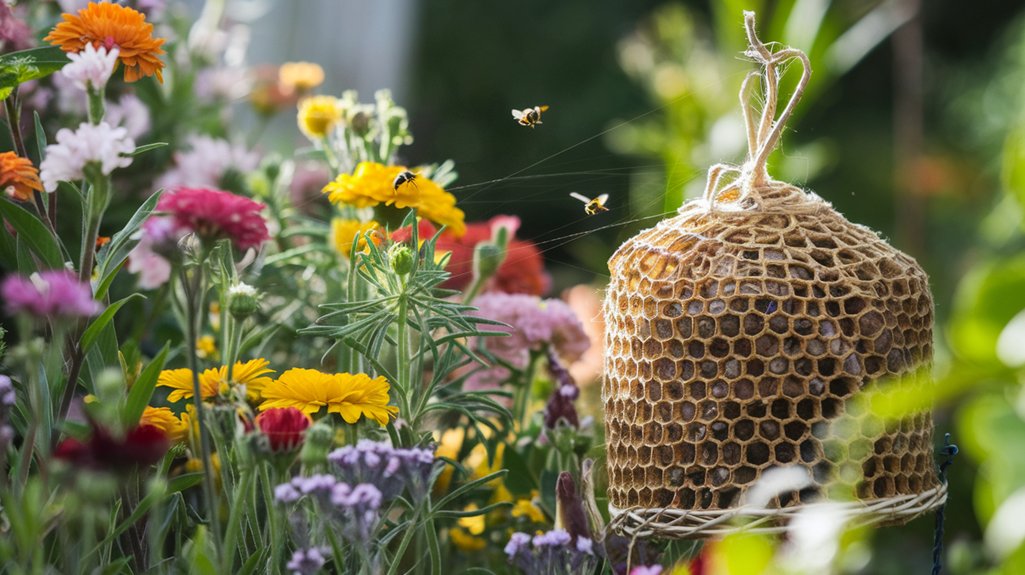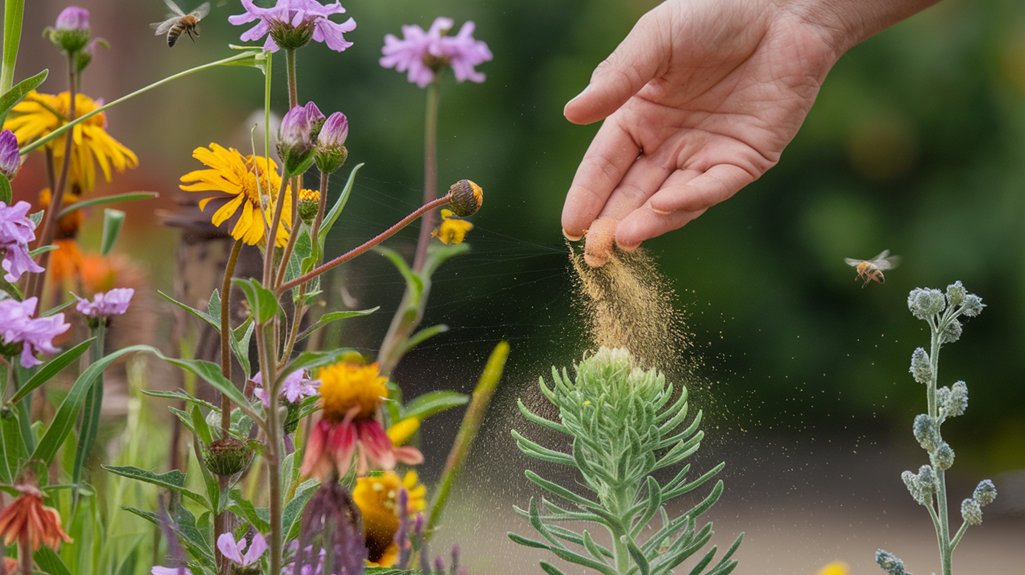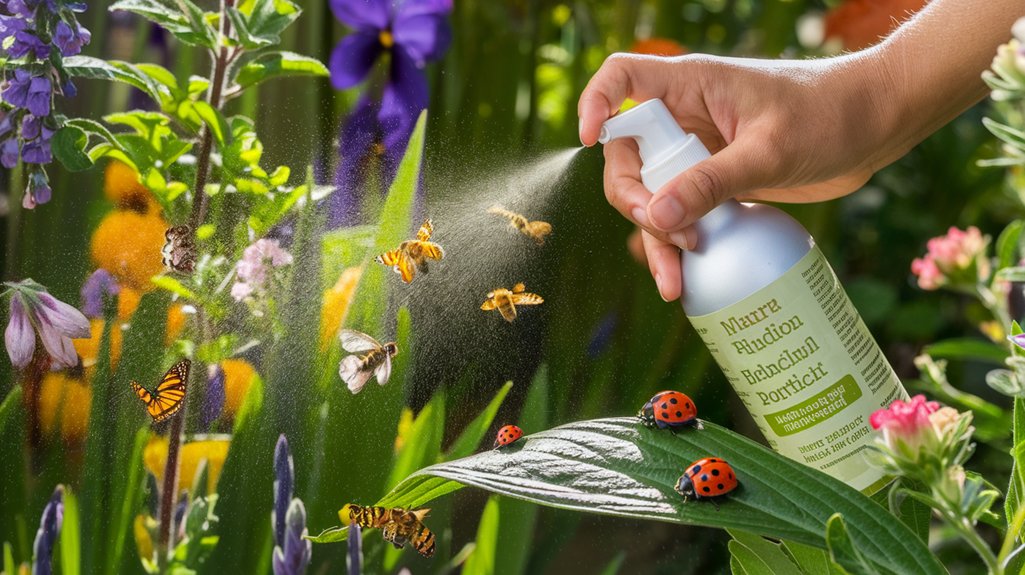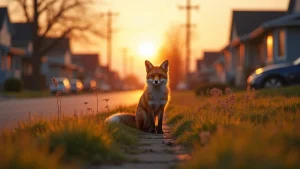When it comes to managing invasive pests in your garden, it’s crucial to consider the impact on pollinators. You want to protect these essential creatures while effectively controlling unwanted bugs. Fortunately, there are eco-friendly methods available that can help you strike this balance. What are these methods, and how can you implement them in your own space? Let’s explore some practical solutions together.
Understanding the Importance of Pollinators

Why should you care about pollinators? These tiny creatures play a massive role in maintaining ecosystem balance. Without them, many plants wouldn’t reproduce, leading to a decline in food sources for both wildlife and humans.
By supporting pollinator habitats, you’re not just helping bees and butterflies; you’re contributing to the health of our environment. Diverse plant life relies on these pollinators to thrive, which in turn supports various species within the ecosystem.
You’ve got the power to make a difference by planting native plants, avoiding pesticides, and creating safe spaces for these essential insects. When pollinators flourish, we all benefit from healthier crops and vibrant landscapes.
Eco-Friendly Pest Control preserves pollinators. Learn from Colorado State University Extension.
Common Invasive Pests and Their Impact

While you might enjoy the beauty of a well-maintained garden, common invasive pests can quickly turn that paradise into a nightmare.
These invasive species, like the Japanese beetle and aphids, wreak havoc on your plants, spreading diseases and stunting growth. They disrupt the ecological balance, outcompeting native species and leading to declines in biodiversity.
You may notice a drop in fruit yield or an increase in plant wilting, which can be frustrating. Furthermore, these pests can attract other unwanted insects, creating a cycle of pest problems.
By recognizing the impact of invasive pests, you can take proactive steps to protect your garden’s health and maintain its beauty without harming beneficial pollinators.
Keep your garden thriving by staying informed.
Natural Pest Control Methods

As you seek to protect your garden from invasive pests, natural pest control methods offer effective and eco-friendly solutions.
One approach is using herbal remedies, like neem oil or garlic spray, which deter pests without harming beneficial insects. You can easily create these mixtures at home, ensuring safety for your plants and pollinators alike.
Another method is biological control, where you introduce natural predators to manage pest populations. For instance, ladybugs can help control aphid infestations, providing a sustainable balance in your garden ecosystem.
Companion Planting for Pest Management
Companion planting offers another innovative approach to pest management, enhancing the natural defenses of your garden. By strategically positioning companion plants alongside your crops, you can create a harmonious environment that naturally deters pests.
For example, marigolds act as pest deterrents, repelling harmful insects with their strong scent. Similarly, planting basil near tomatoes not only boosts their flavor but also protects them from whiteflies.
You’ll find that certain plants attract beneficial insects, like ladybugs, which feast on aphids. This method encourages a balanced ecosystem, reducing the need for chemical interventions.
Essential Oils and Natural Repellents
When you’re looking for effective ways to keep pests at bay, essential oils and natural repellents can be powerful tools in your eco-friendly arsenal.
Essential oil blends like peppermint, lavender, and tea tree oil work wonders as natural deterrents against common insects. You can easily create your own spray by mixing a few drops of these essential oils with water and a bit of dish soap in a spray bottle.
Just a few spritzes around your garden or home can help repel annoying bugs without harming beneficial pollinators. Plus, the pleasant aroma can enhance your space.
Remember to reapply your mixture regularly, especially after rain, to maintain its effectiveness and keep those invasive pests away naturally.
Attracting Beneficial Insects
Attracting beneficial insects can transform your garden into a thriving ecosystem, so it’s essential to create an environment that draws them in.
Start by planting a variety of beneficial plants, like marigolds, yarrow, and dill, which provide food and shelter for these helpful critters. Incorporate a mix of flowering plants that bloom at different times to ensure a continuous supply of nectar, attracting pollinators throughout the growing season.
Avoid using pesticides, as they can harm these valuable insects. Instead, focus on natural methods to maintain balance in your garden.
Physical Barriers and Traps
Implementing physical barriers and traps can effectively keep pests at bay while maintaining an eco-friendly approach in your garden. You can use various physical deterrents such as row covers, nets, and fences to shield your plants from invasive bugs.
These barriers not only prevent pests from reaching your crops but also protect beneficial insects like pollinators. Additionally, consider employing trapping techniques, such as sticky traps or baited traps, to capture unwanted pests without using harmful chemicals.
Place these traps strategically around your garden to maximize their effectiveness. Regularly check and maintain your barriers and traps to ensure they continue to work well.
Organic Pesticides: What to Know
After setting up physical barriers and traps, you might find that some pests still manage to infiltrate your garden. When that happens, organic pesticides can be your next line of defense.
These products, derived from natural sources, must meet specific pesticide regulations to ensure they’re safe for both you and the environment. Look for those with an organic certification, as this guarantees they’ve been evaluated for efficacy and safety.
Creating a Pollinator-Friendly Garden
How can you create a garden that not only flourishes but also supports vital pollinators? Start by choosing native plants that thrive in your region. These plants provide the nectar and pollen essential for bees, butterflies, and other pollinators. Aim for garden diversity by incorporating various species, blooming at different times, ensuring a continuous food source.
Here’s a quick reference:
| Plant Type | Benefits |
|---|---|
| Wildflowers | Attracts diverse pollinators |
| Shrubs | Provides shelter and nesting |
| Herbs | Offers edible flowers and scents |
Frequently Asked Questions
How Can I Identify Invasive Bugs in My Garden?
To identify invasive bugs in your garden, observe their size, color, and behavior. Look for common invasive species characteristics like unusual markings or rapid reproduction. Keep a guide handy for accurate garden bug identification and comparison.
Are There Specific Plants That Repel Invasive Pests?
Yes, certain plants can repel invasive pests. By using herbal repellents like basil and marigold in companion planting, you’ll create a natural barrier that helps protect your garden while promoting a healthier ecosystem.
What Are the Risks of Chemical Pesticides to Pollinators?
Chemical pesticides pose significant risks, as their toxicity can lead to pollinator decline. You should be mindful of the impact these substances have on beneficial insects, as their health is crucial for our ecosystem’s balance.
How Often Should I Apply Natural Pest Control Methods?
You should apply natural pest control methods every 1-2 weeks, following frequency guidelines for specific pests. Adjust application methods based on effectiveness, weather conditions, and plant health to ensure optimal protection and results.
Can I Use Homemade Remedies for Pest Control?
Yes, you can use homemade remedies for pest control. Natural insecticides and DIY repellents can be effective against pests. Just ensure you choose ingredients that won’t harm beneficial insects or your plants while applying them.
By embracing eco-friendly pest control methods, you can protect both your garden and vital pollinators. Utilizing natural remedies, companion planting, and attracting beneficial insects creates a balanced ecosystem that keeps invasive pests at bay. Remember, a diverse garden not only thrives but also minimizes the need for harmful chemicals. So, take action today—implement these strategies to ensure a healthier environment for all, and watch your garden flourish while supporting the essential role of pollinators!
Contact Us
Eco-Friendly Pest Control with Above & Beyond Services keeps your Denver garden thriving. Call (720) 806-6378 or visit Above & Beyond Services for free quotes on pest control, lawn care, and more.
Key Takeaways
- Utilize natural pest control methods like neem oil and garlic spray to deter invasive bugs safely without harming pollinators.
- Introduce beneficial insects, such as ladybugs, to naturally manage pest populations while promoting ecological balance.
- Implement companion planting by pairing plants like marigolds and basil to repel pests and attract pollinators.
- Choose native plants that provide nectar and pollen, creating a supportive environment for pollinators while deterring invasive pests.
- Maintain garden diversity with various blooming species to ensure continuous food sources for pollinators and reduce pest outbreaks.




